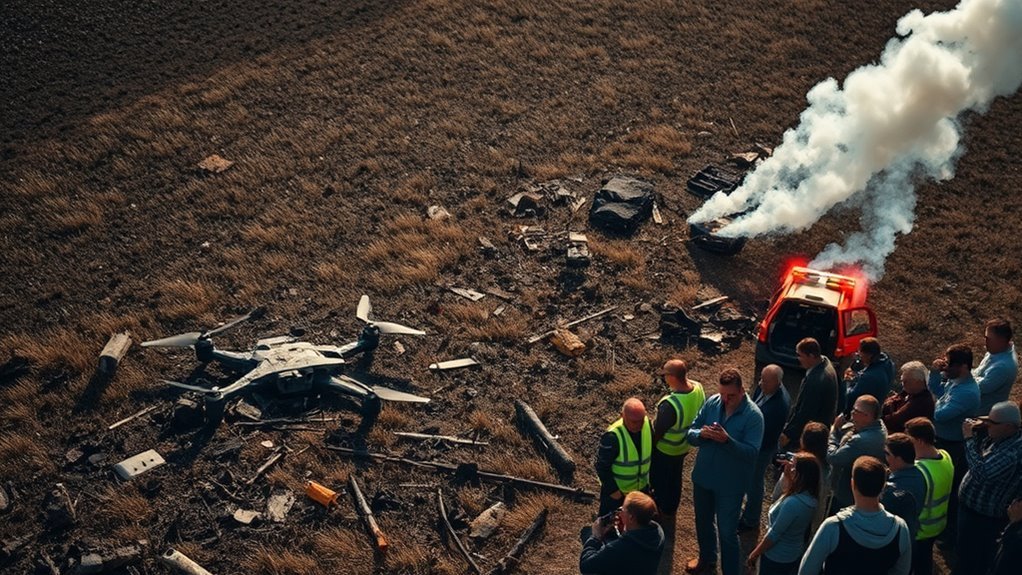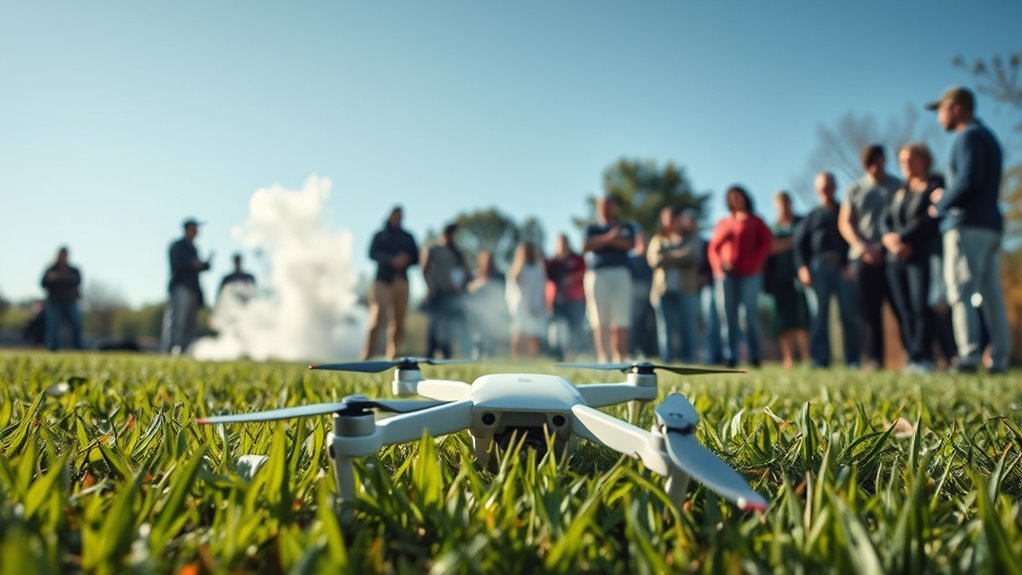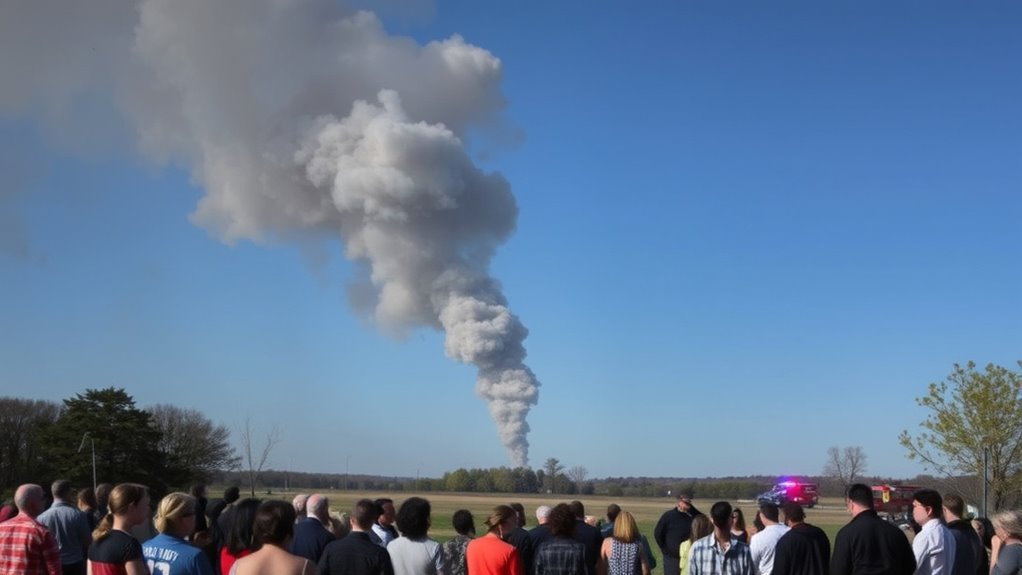The recent drone crash in New Jersey raises significant concerns about pilot error, regulatory compliance, and technological vulnerabilities. This incident involved a commercial drone losing control and colliding with a building, prompting an investigation into safety practices and equipment reliability. Current FAA guidelines play an essential role in ensuring safe operations, but local regulations can complicate compliance. Understanding these issues is important, and there’s more to uncover about the implications for drone operators and future regulations.
Overview of the Drone Crash Incident

In light of recent events, the drone crash in New Jersey has raised concerns about safety regulations and operational protocols. The incident involved a commercial drone that reportedly lost control and collided with a building, sparking a crash investigation. As you consider the implications, it’s vital to recognize how drone technology, while innovative, presents unique challenges. The investigation aims to identify the cause of the crash, examining factors like pilot error, equipment malfunction, or environmental conditions. These findings will not only shed light on this specific incident but also influence future guidelines for drone operations. Ensuring safety while embracing technological advancements is essential for fostering a culture of responsible drone use, allowing individuals the freedom to explore this evolving field.
Safety Regulations Governing Drone Operations

When operating drones, it’s vital to understand the FAA guidelines that govern their use, as they set the baseline for safety and operational standards. Additionally, local ordinances can further impact how you fly drones in specific areas, potentially imposing restrictions that vary by location. Recognizing these regulations is essential for ensuring compliance and promoting safe drone operations.
FAA Drone Guidelines
While operating drones can be an exciting endeavor, it is crucial to adhere to the FAA’s guidelines to guarantee safety and compliance. These regulations cover various aspects, including drone registration and flight altitude limits, ensuring you’re not only flying responsibly but also legally.
| Guideline | Description |
|---|---|
| Drone Registration | All drones over 0.55 lbs must be registered. |
| Flight Altitude | Maximum altitude is 400 feet AGL. |
| Visual Line of Sight | Always maintain visual contact with your drone. |
| No Fly Zones | Avoid flying near airports or restricted areas. |
Understanding and following these guidelines will empower you to enjoy your drone experience while minimizing risks and legal issues.
Local Ordinances Impacting Operations
Local ordinances can greatly impact your drone operations, often introducing additional restrictions beyond federal guidelines. Understanding these local laws is essential to guarantee compliance and avoid penalties. Each municipality may enforce its own operational restrictions, which can vary considerably.
- Height limits may be imposed, restricting how high you can fly.
- Certain areas, like parks or schools, may be off-limits for drone use.
- Noise regulations could limit the times you can operate your drone.
- Registration and permitting might be required for local flights.
Being aware of these local regulations not only keeps you within the law but also promotes safe, responsible flying. Always check with local authorities before your next flight to stay informed about any changes that could affect your operations.
Impact on Local Communities and Airspace

Given the increasing prevalence of drone usage in New Jersey, the recent drone crash has raised significant concerns about its impact on local communities and airspace. You might be wondering how this incident affects your neighborhood. Community awareness is vital; residents need to understand the risks drones pose and how they can mitigate them. The crash has highlighted the necessity for better airspace management, as unregulated drone flights can lead to dangerous situations. Local authorities may need to reevaluate existing policies to guarantee safe integration of drones into shared airspace. Ultimately, fostering a cooperative environment between drone operators and community members will be essential in addressing safety concerns while encouraging innovation in this emerging field.
Technological Factors Contributing to the Crash
As drone technology continues to evolve, several technological factors can greatly contribute to crashes, including software malfunctions and hardware failures. Understanding these issues is essential for improving safety and reliability in drone operations.
- Sensor malfunctions can lead to inaccurate data readings, affecting navigation and stability. The lack of redundant systems can exacerbate the effects of such malfunctions, increasing the likelihood of crashes.
- Software errors often occur in the flight control system, causing unexpected behavior during operation.
- Battery failures might result in sudden power loss, leaving the drone unable to maintain altitude.
- Poor communication systems can hinder the drone’s ability to receive real-time updates, leading to potential collisions. Additionally, the drone’s collision avoidance system is crucial for preventing accidents by detecting obstacles in real-time.
Lessons Learned for Drone Operators
Understanding the lessons from the NJ drone crash can greatly enhance your operational practices. Emphasizing safety protocols, performing thorough pre-flight checks, and ensuring regulatory compliance are essential steps you should prioritize. These measures not only safeguard your equipment but also protect public safety and maintain your credibility as a drone operator. Additionally, being aware of signal attenuation can help you choose appropriate flight paths and avoid potential crashes caused by loss of communication. It is also crucial to ensure that you have completed mandatory registration with the General Civil Aviation Authority before operating your drone.
Safety Protocols Importance
While it might seem straightforward to fly a drone, the recent NJ drone crash underscores the critical importance of adhering to established safety protocols. Ignoring drone safety and operational guidelines can lead to disastrous consequences. For drone operators, understanding and implementing these protocols is essential for preventing accidents and guaranteeing a safe flying experience.
- Always stay informed about local regulations and airspace restrictions.
- Conduct thorough pre-flight checks to verify equipment functionality.
- Maintain visual line of sight with your drone at all times.
- Be aware of your surroundings, including people, animals, and obstacles.
Pre-Flight Checks Essential
Before taking to the skies, it’s crucial for drone operators to conduct thorough pre-flight checks, since overlooking this step can lead to major mishaps. A detailed pre-flight checklist is essential to guarantee all systems are functioning properly. This includes checking battery levels, inspecting propellers for damage, and verifying GPS functionality. By performing these drone inspections, you greatly reduce the risk of in-flight issues that could compromise safety and operational integrity. Additionally, conducting these checks fosters a proactive mindset, allowing you to identify potential problems before they escalate. Remember, a few minutes spent on pre-flight preparations can save you from costly repairs, accidents, and legal complications down the line. Embrace the responsibility that comes with drone operation by prioritizing these critical checks.
Regulatory Compliance Necessity
Regulatory compliance is not just a legal obligation for drone operators; it’s an essential aspect that can greatly impact flight safety and operational success. Staying updated with regulatory updates is crucial, as failure to comply can lead to serious compliance challenges. Understanding these regulations helps you navigate the complexities of drone operation more effectively.
- Familiarize yourself with local and federal regulations.
- Stay informed about changes in policies and procedures.
- Implement a checklist for compliance before each flight.
- Attend workshops or training sessions on regulatory best practices.
Future of Drone Safety and Regulation
As the use of drones continues to expand across various sectors, ensuring their safety and regulation becomes increasingly vital. The future of drone safety relies on innovative technologies and thorough regulations. You’ll see safety advancements intertwined with drone innovations that encourage responsible usage. Advanced collision avoidance features are essential for enhancing safety and compliance within drone operations. Additionally, adherence to FARs will be crucial for maintaining operational standards and minimizing risks associated with drone flights.
| Aspect | Current Status | Future Outlook |
|---|---|---|
| Regulation | Fragmented | Unified standards |
| Technology | Basic sensors | Advanced AI systems |
| Public Awareness | Limited | Increased education |
| Compliance | Voluntary | Mandatory requirements |
| Incident Reporting | Reactive | Proactive measures |
This framework can help maintain freedom in drone usage while prioritizing public safety. Balancing innovation with regulation will be essential for a sustainable future in this rapidly evolving field.
Frequently Asked Questions
What Type of Drone Was Involved in the Crash?
The drone specifications are vital for understanding the crash. In the ongoing crash investigation, it’s essential to analyze the model involved, as this can reveal potential design flaws or operational issues that led to the incident.
Were There Any Injuries Reported From the Incident?
You’d think injury reports from such a dramatic crash investigation would flood the news, but fortunately, no serious injuries were reported. The incident’s aftermath seems more about procedural reviews than medical emergencies, thankfully.
How Many Drones Are Currently Registered in NJ?
As of now, there are over 6,000 drones registered in New Jersey. Understanding the drone regulations and the registration process is essential for operators to guarantee compliance and enjoy the freedom of flying legally.
What Are the Penalties for Illegal Drone Operation?
When you engage in illegal drone operations, you face penalties that may include fines, confiscation of equipment, or even criminal charges. Understanding this penalties overview is essential for responsible drone use and ensuring your freedom remains intact.
Can Drone Operators Receive Insurance for Crashes?
Yes, you can obtain drone insurance that covers crash liability. This insurance helps protect you financially in case of accidents, ensuring you’re not solely responsible for damages, which can lead to significant costs and legal issues.

